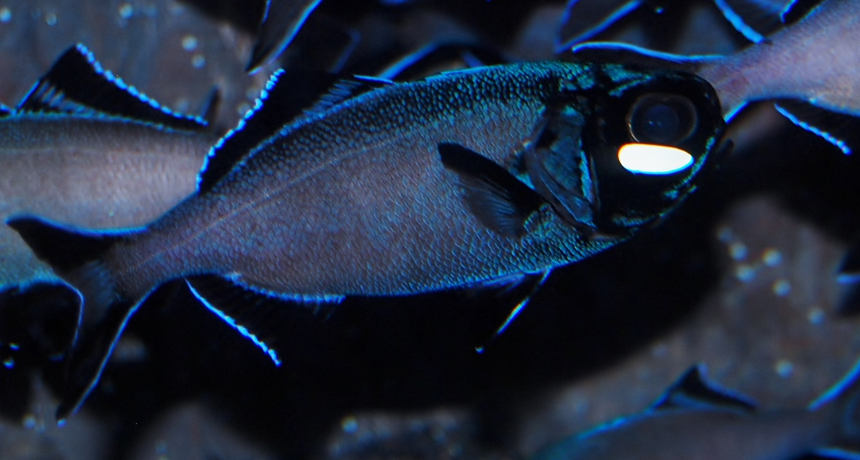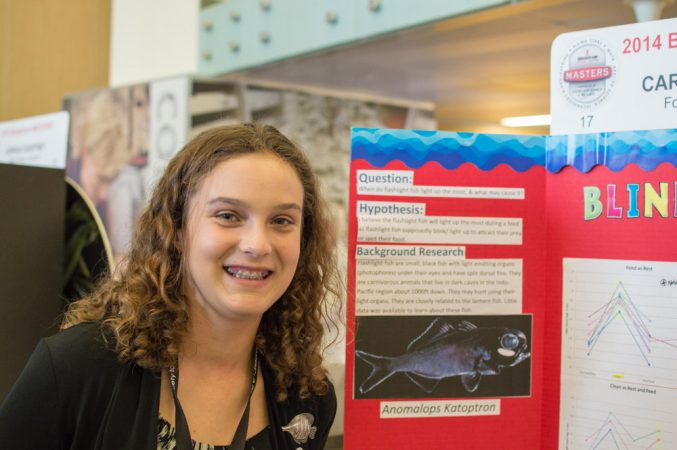Teen studies living flashlights of the deep
A teen’s videos help chronicle behavior of the giant flashlight fish

The bluish-black giant flashlight fish (shown here) gets its name from a bioluminescent patch located below each eye.
Caroline Edmonds
By Sid Perkins
The deep sea is one of the most remote and mysterious places on Earth. Scientists rarely go there. Those few who do discover new species all of the time. Many denizens of the deepest parts of the ocean, where it’s forever dark, can light up. Now, a teen’s research has shone new light on how one of these swimming beacons behaves in captivity.
The giant flashlight fish (Anomalops katoptron) lives in the Indian Ocean as well as in tropical parts of the central and western Pacific. It roams at depths of up to 400 meters (about 1,300 feet). But not always. Sometimes it inhabits coral reefs in shallow waters. In those shallow waters, this blackish-blue fish comes out only at night. Reef-dwelling members of this species tend to be smaller than those living in deeper waters. Those biggies can grow to lengths of 35 centimeters (14 inches). That may not sound like a giant, but they are the largest of their type of fish.
The giant flashlight fish gets its name from a small glow-in-the-dark patch found in a pocket of tissue under each eye, explains Caroline Edmonds. She’s a 13-year old from Fountain Valley, Calif. There, she attends Talbert Middle School. The eye pockets in these fish contain light-producing — or bioluminescent (BY-oh-loom-in-ESS-ent) — bacteria.

When a fish wants to “flash” its light, it rotates the bacteria-filled pocket toward the outside of its body, Caroline explains. When a fish wants to hide its light, it swivels the pocket back toward the inside.
Researchers had never made any detailed measurements about when and why this fish uses its lime-green flashlights. So, Caroline asked to study the species at the Aquarium of the Pacific in Long Beach, Calif. She has worked there as an unpaid volunteer for the past three years.
For her study, Caroline made 94 videos of the fish. Her videos covered all times of the day, even the middle of the night. Each video lasted 5 minutes. To measure the behavior of the fish, she paused each video every 5 seconds to check and see if any of the fish in a school were exposing their glowing patches.
No one had been sure why the fish developed their glow-in-the-dark beacons. To attract a mate, to lure food or to confuse a predator are just a few possible examples. Caroline hoped to home in on the actual reason. Her data now show that the fish flashed most often when they were being fed. They flashed least often late at night, when they were resting. (Aquarium workers turn on the lights each morning at about 7:30 a.m. and turn them off at 9:00 p.m., Caroline notes. That simulates the night.)
This artificial day-and-night schedule doesn’t match the activity cycle this fish would experience in the wild. Still, Caroline says, it might provide interesting clues about the species’ behavior. For one thing, the fish lit up more when being fed small frozen crustaceans than they did when hunting live prey. Maybe the fish were trying to be sneaky when they were tracking prey that could escape, she says.
Caroline presented the results of her research to the public this week in Washington, D.C., at the finals of the fourth annual Broadcom MASTERS (Math, Applied Science, Technology and Engineering for Rising Stars) contest. It’s a national competition for middle school students. The program is run by Society for Science & the Public (SSP), publisher of Science News for Students. It is sponsored by Broadcom Foundation (a nonprofit public benefit corporation funded by Broadcom Corp.).
Power words
aquarium A tank with at least one transparent side where water-dwelling plants and animals can be kept and observed.
bacterium (plural bacteria) A single-celled organism. These dwell nearly everywhere on Earth, from the bottom of the sea to inside animals.
bioluminescence The light emitted by certain animals —such as fireflies, squid and deep-sea fishes — and by some shallow-water algae.
crustaceans Hard-shelled water-dwelling animals including lobsters, crabs and shrimp.
predator (adjective: predatory) A creature that preys on other animals for most or all of its food.
prey Animal species eaten by others.
symbiosis A relationship between two species that live in close contact.







